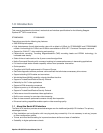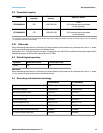
10 Pipeline HD SATA Product Manual, Rev. F
Introduction www.seagate.com
In addition, Serial ATA makes the transition from parallel ATA easy by providing legacy software support. Serial
ATA was designed to allow you to install a Serial ATA host adapter and Serial ATA disk drive in your current system
and expect all of your existing applications to work as normal.
The Serial ATA interface connects each disk drive in a point-to-point configuration with the Serial ATA host
adapter. There is no master/slave relationship with Serial ATA devices like there is with parallel ATA. If two drives
are attached on one Serial ATA host adapter, the host operating system views the two devices as if they were both
“masters” on two separate ports. This essentially means both drives behave as if they are Device 0 (master)
devices.
The Serial ATA host adapter and drive share the function of emulating parallel ATA device behavior to provide
backward compatibility with existing host systems and software. The Command and Control Block registers, PIO
and DMA data transfers, resets, and interrupts are all emulated.The Serial ATA host adapter contains a set of
registers that shadow the contents of the traditional device registers, referred to as the Shadow Register Block. All
Serial ATA devices behave like Device 0 devices. For additional information about how Serial ATA emulates
parallel ATA, refer to the “Serial ATA International Organization: Serial ATA Revision 3.0”. The specification can be
downloaded from www.sata-io.org.
Note
The host adapter may, optionally, emulate a master/slave environment to host software where two
devices on separate Serial ATA ports are represented to host software as a Device 0 (master) and Device
1 (slave) accessed at the same set of host bus addresses. A host adapter that emulates a master/slave
environment manages two sets of shadow registers. This is not a typical Serial ATA environment.


















